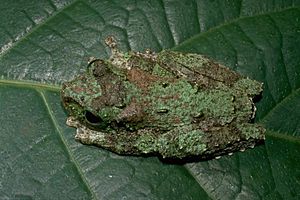Green-eyed tree frog facts for kids
Quick facts for kids Green-eyed tree frog |
|
|---|---|
 |
|
| Conservation status | |
| Scientific classification | |
| Synonyms | |
|
The green-eyed tree frog is also known by other names like the brown-spotted tree frog, fringed tree frog, or New Guinea tree frog. Its scientific name is Ranoidea genimaculata. This amazing tree frog lives on the island of New Guinea. You can find it almost everywhere on the island, from lowlands up to about 1500 meters (about 4,900 feet) above sea level. It lives in both Papua New Guinea and Indonesia.
Some of these frogs also live in Queensland, Australia, especially near the Great Barrier Reef. However, scientists are still debating if the Australian frogs are the same species as the ones in New Guinea. Some think they are one species, while others believe they are two or even three different species!
Contents
What Does It Look Like?
The green-eyed tree frog has some unique features. Adult male frogs are about 4.6 cm (1.8 inches) long, while the females are larger, growing up to 7.1 cm (2.8 inches).
The most noticeable thing about this frog is the bright green ring around its eyes, which gives it its common name. Its body is usually a brownish-green color with patches that look like lichen, which is a type of plant-like growth often found on wet rocks. This special coloring helps the frog hide from larger animals that might want to eat it.
This frog also has very large, sticky discs on its toes. These discs help it climb easily. Another interesting feature is a small bit of skin on its back legs that looks like fringe. This is why it's sometimes called the "fringed tree frog."
Where It Lives and How It Behaves
These frogs prefer to live near rocky streams. You'll often find the male frogs staying close to the water. The female frogs, however, are excellent climbers and tend to climb high into the trees.
When it's time to lay eggs, the female frog will lay hundreds of them at once in pools of water. This helps ensure that many baby frogs will hatch and survive.
Identifying Individual Frogs
The green-eyed tree frog has patterns on its back that can look like an hourglass. Scientists once thought they could use these patterns to identify individual frogs, like a unique fingerprint. However, they discovered that the hourglass pattern actually changes shape as the frog grows older. This makes it tricky to use for long-term identification.
Conservation Status
Currently, the green-eyed tree frog is not considered an endangered species. This means there are still many of them in the wild. However, scientists are concerned because a fungal disease called chytridiomycosis or a virus may have caused the deaths of many of these frogs in the past. Scientists continue to monitor their populations to make sure they stay healthy.
Images for kids
-
Dunk Island rain forest in Queensland Australia.
See also
 In Spanish: Rana arborícola de ojos verdes para niños
In Spanish: Rana arborícola de ojos verdes para niños





